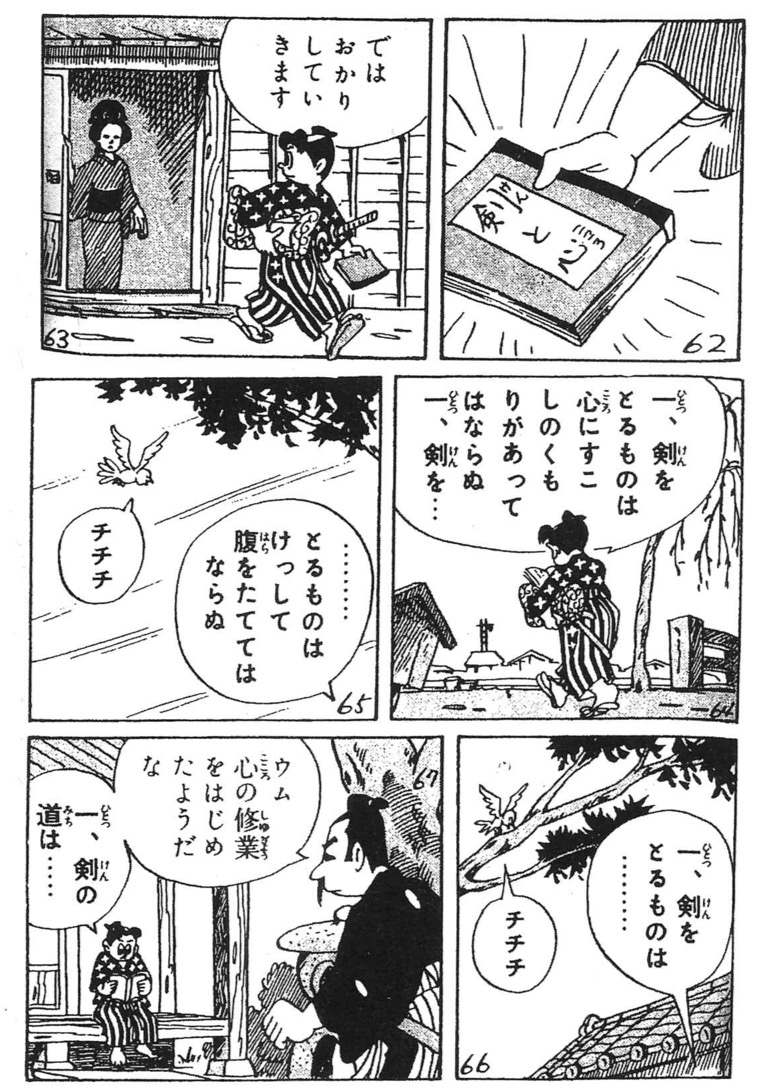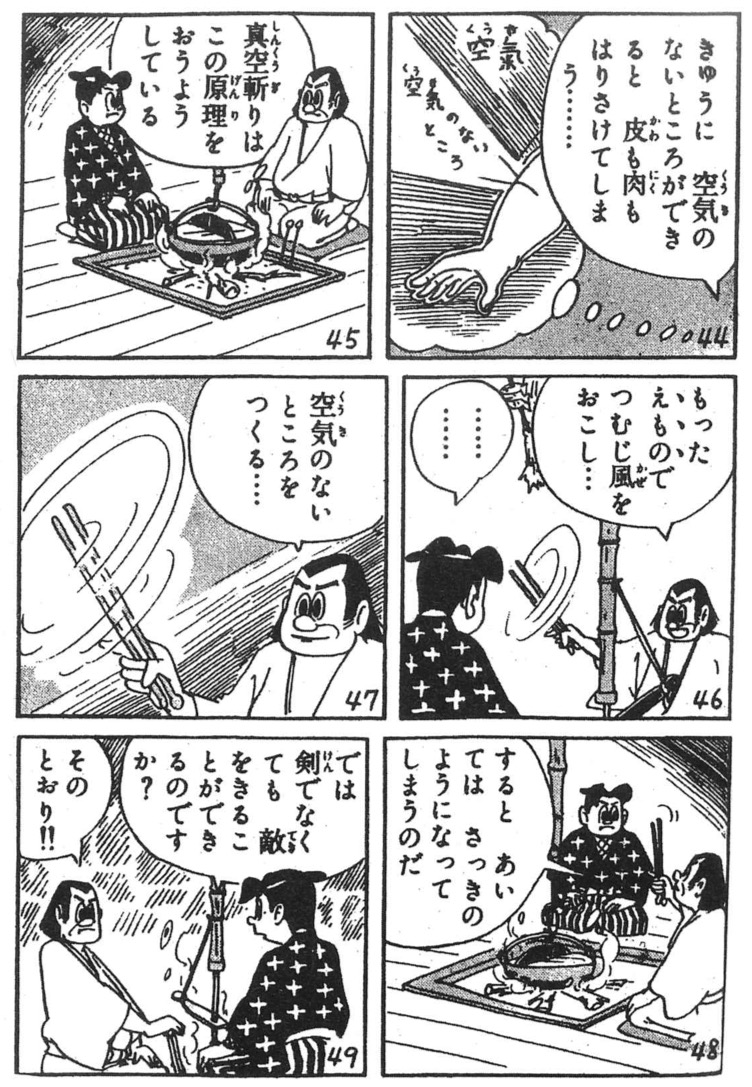“Manga ni okeru shūgyō imēji no denshō”
From Natsume Fusanosuke, Moro Shigeki, Li Baohua, Ochi Hiroko, Nomura Hideto, Yamada Setsuko, Karada no bunka: shūgyō to shintaizō (Culture of Bodies: Training and Images of Bodies). Goyō Shobō: 2012.
Readers of TCJ will know Natsume Fusanosuke as a “manga columnist” (manga korumunisuto) who often pens short, witty, loose pieces about manga works from both the present day and previous decades. Sometimes, as with more recent essays that we have translated for the website, such as his those on Miyaya Kazuhiko, Ikegami Ryōichi’s Supaidāman, and How to Draw Comics the Marvel Way, his writing style is super-casual. Scholars John Ingulsrud & Kate Allen find that “a great deal of manga commentary is not written in expository prose… each speaker tends to ‘speak’ in a paragraph.”1 And in those essays, Natsume indeed “speaks” to us. The tone is very subjective, as Natsume often conflates his autobiography with both manga history and manga criticism. Furthermore, as someone who regularly appeared on Japanese television for shows about manga—such as Manga yawa (Manga Night Talks), which aired on NHK’s BS2 satellite tv network from 1996 to 2009—the conversational style of analyzing and discussing comics served him well. Again, Ingulsrud & Allen cite Natsume’s own term for this (“criticism with amusement,” hihyōteki goraku), as more “appropriate” and “satisfying” for manga study, “given manga’s place in popular culture.”2
The below essay, however, is an entirely different beast. Of all the translations we have done of Natsume’s work for TCJ, this is the clearest example of the author employing his scholarly voice. It is nonetheless highly accessible and very informative, providing a very specific slice of the history of training and bodies illustrated in manga.
This 2012 article was originally published in a co-edited volume entitled Culture of Bodies: Training and Images of Bodies (Karada no bunka: shugyō to sintaizō), which grew out of a symposium held at Gakushūin University. Natsume taught as a professor at that prestigious institution for 13 years before he retired in March 2021. The focus of the book is on the visualization of bodies in Japanese culture, specifically on the theme of the training of the body to perform certain tasks; experts from a wide variety of fields discuss such images in areas like manga, zazen, Chinese martial arts, piano education, breathing methods, contemporary dance, and more. Although the aforementioned translations of Natsume have showed him relaxed and poking fun at himself while he digs into some of his favorite manga, we have translated some instances of Natsume employing this voice too, such as his articles about Hasegawa’s Sazae-san and Tezuka’s Barbara. Certainly here he is rigorous in precisely tracing a kind of genealogy of “training” (shugyō) through decades of manga exemplars.
When you look up shugyō in a dictionary, you will find the following definitions: training; acetic practice; study; and so on. While all these words are related to "training" yourself in a broader sense, you will find that shugyō involves not just physical training, but also a spiritual aspect, among other dimensions to its meaning. From this essay, foreign readers will better understand how important and deeply rooted the trope of “training” is in Japanese culture (no “wax on, wax off” jokes, please); through the depictions of shugyō, Natsume explores the intertextual play across Japanese visual media, including kamishibai, ninja novels, period-piece movies, and so on. (As you will see, though Natsume finishes his arc with manga in the late 1990s, he admits he should have done more to include shōjo manga within his scope, limited as he was by the print volume’s space constraints.)
For the Japanese audience, however, Natsume goes further to describe how manga images not only reflect but also inform Japanese people about how they might understand their own bodies in contemporary society. By the article’s end, he almost has sketched out a kind of ontological or phenomenological position within contemporary manga that can be identified if one is carefully reading those works. By analyzing the depictions of training bodies and their relationships to other forms of Japanese culture, Natsume argues that we can also see how an individual’s own self-image is pitted against social norms, especially as those norms differ across phases in Japanese history. Perhaps we can see that, over longer periods of time, those very images of heroes jumping, exercising, and being tortured alter the reader’s view of their own body, ultimately spiraling out and affecting a larger shift in the general societal perception of what’s real and what’s true. Those are the stakes of Natsume’s argument. For readers who desire to know further connections these manga have to sociology, philosophy, and history, please refer to scholars of those fields that the author brings in for support throughout his essay.
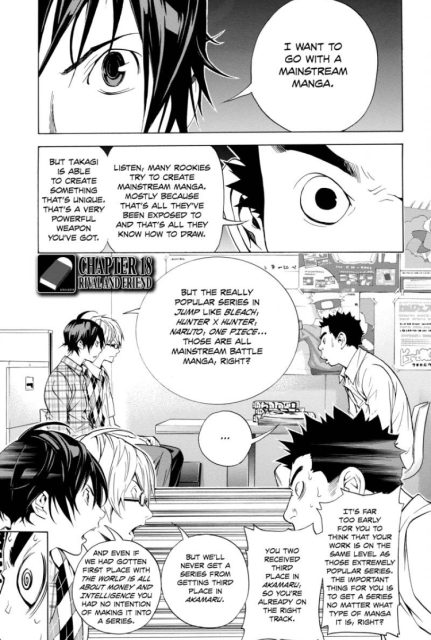
The translators thank Natsume-sensei for allowing us to translate and publish this work of scholarship, with its great potential to launch future investigations in Comics Studies about images of physicality in manga, and even comics beyond Japan’s borders.
-Jon Holt & Teppei Fukuda
* * *
Part 1: Images and Icons of the Body in Manga and Modernity
If we wonder how bodies have come to be drawn in manga, it might seem utterly obvious, but my premise begins with that the fact that these bodies consist of pictures (e or zuzō). As they are pictures, we would expect that, in theory, authors could draw bodies in whatever crazy ways they want. On the other hand, we also might expect that they could be sketched in a realistic (shajitsu-teki) way. We might use the word “pictures,” but through the way an artist draws them, there really are many ways the body can be visualized. For example, in art from long ago, there are portrait pictures, likenesses, etc., so the body was illustrated to show actual people in ways that matched their real appearance. Depending on the situation, sometimes bodies are drawn in anthropomorphized animal styles, and we have also seen over time bodies drawn that seem to possess mythical or transcendent powers (like flying in the sky).
When the body is drawn in “picture form,” we see the way people thought, the time they lived in, and social ideologies forming base ideas for their drawings. And sometimes those people illustrate bodies flying in the sky with supernatural or religious power, or they depict people doing crude and wild actions for humor. When we see these pictures and consider the thought of their times and the parent society, even those with realistically drawn bodies, such practices are founded on a kind of thought that faithfully and realistically visualized space in three-dimensions from a fixed point (thus the establishment of perspective), which was fully appreciated as a form of art in Europe from the Renaissance on - and then we in Japan imported these artistic techniques and thought with the beginning of our Modern Period [i.e., from 1868 and on].4
On the other hand, when it comes to the mass media known as manga, its form of exaggerated expression, which is quite different from the aforementioned focus on realism, becomes an incredibly important factor. If I may speak broadly, in modern aesthetics the method of realistic depiction was orthodox, whereas expression by exaggeration was positioned as mere “play” (asobi) and something inferior, since its method breaks the semblance of realism. And because European realism is a more recent development, the kind of versatile and free form of expression found in manga could be thought of as deriving from a much more traditional way of thinking about art and pictures.
I say that, but we should realize that the kind of expression that we see today in manga is very much founded on a kind of thought that only developed from the modern period. Some important aspects of that can be seen in 1) how the [manga] story is divided up with sequential panels to show a constructed sense of time; and 2) that manga is read by means of the way that numerous panels have a kind of reciprocal relation to each other. The temporal expression by these sequenced panel frames has existed since antiquity, for example, in religious art. Even so, it is a product of the early modern era (kindai) in the way a time segment of a story which will appear to us as “now” (genzai) in our experience of “reading” it.5 As for the premodern sense of time, the mythic past directly co-existed with the present day. In traditional societies, it is said that people in their own time existed while normally reciprocally associating their own moment with the olden times of mythic past. The experience we now have is that we think that an individual existence is separated from its past and its future. Such a modern experience really only became possible to imagine when modern thought became the new paradigm.6
With this information as a premise, I would like to reconsider the image of bodies in manga.
Part 2: Training and Bodies in Prewar Children’s Manga
At this point I would like to think about what kind of body images we see in postwar Japanese comics particularly from the “training” aspect. Shugyō (“training”) is something that takes much time as one works to improve and change one’s body, but as I trace this kind of expression, we might be able to concretely find an answer to the question “how do we grasp the body?”
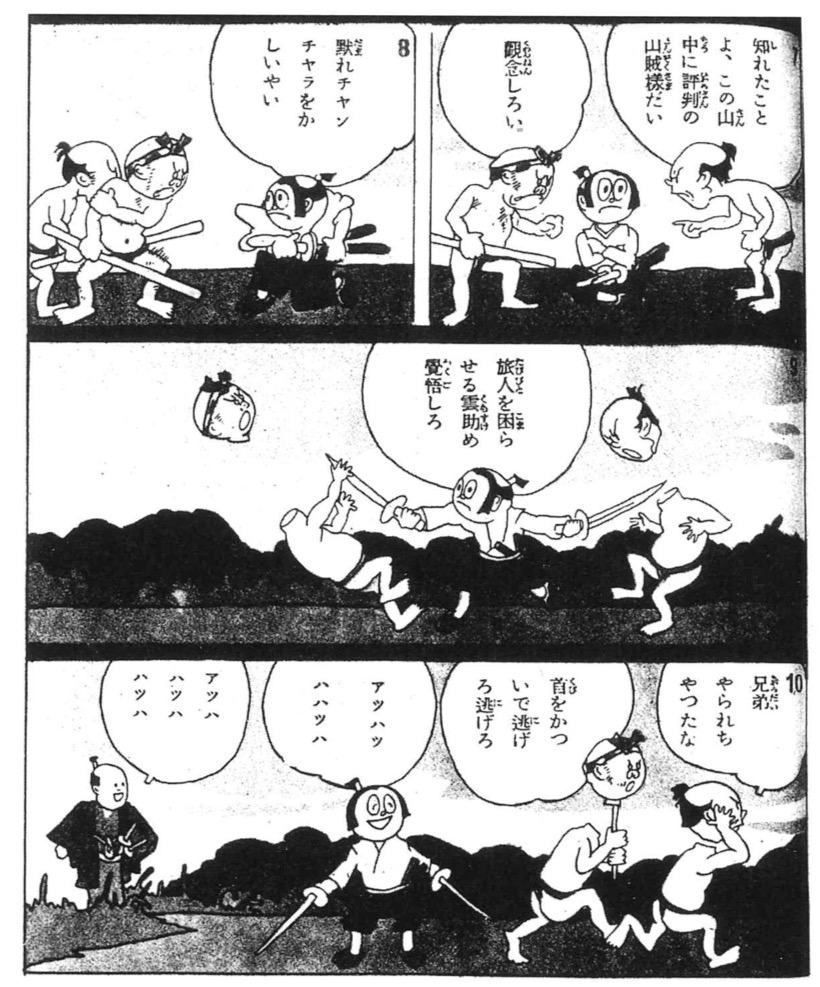
To start our discussion of postwar manga, I want to first start out looking a bit at prewar manga bodies. In adult-oriented manga, there are sexy-looking female bodies, caricatures made for the purpose of political satire, and characters drawn for each and every social class so as to symbolically portray common society; and yet, these reproductions of the body have been seriously considered by others for the way they emphasize elements that “look familiar” in their social experience in the real world.7 On the other hand, those fantastic expressions, for which manga can fully utilize the fact that manga is just a picture, came about in the kind of manga geared towards children and popular with this audience from about the Taishō Era [1912-1926]. If we look at a scene from Tagawa Suihō’s Shinshū Sakuranosuke (Figure 1), which began in Shōnen Club (Shōnen Kurabu) magazine in 1933, his protagonist makes light and easy work lopping off the heads of the bad guys, and those decapitated thugs take hold of their own heads, running away quite carefree, saying, “Brother, we got beat!” The protagonist stands there laughing “A-ha-ha-ha-ha-ha-ha!” and shows not an ounce of guilt. It is because the villains are so carefree with their bodies—their heads may have been cut off, but their bodies do not have them worried about their deaths even in this situation—that they take their defeat all too easy. And that is also why Tagawa’s story can be innocent “fun”.
Bodies with this kind of free and easy plasticity actually can be seen a bit earlier in the cartoons of the 19th century Swiss artist Rodolphe Töpffer (sometimes called the father of modern comics), and in Max and Moritz by the German artist Wilhelm Busch; the latter cartoon series, with its mischievous kids, came to be published even in Japan as early as 1887 or 1888. In it, we see bodies that absolutely defy death, becoming a part of the lineage of rubber-like bodies that can stretch back and forth, and bodies that easily recover even if they get pressed and flattened, which we see in slapstick movies and animation films that began to be popular around this time. Nowadays, the rubber body of Luffy, the protagonist of Oda Eiichirō’s megahit One Piece (serialized in Weekly Shōnen Jump) is very much a descendant in this lineage of stretchy cartoon bodies. (Luffy, if he does become cut, can die, but his prototype is in bodies like these.)

What about the aspect of “training” (shugyō) when it comes to these images of the body? If we look at another work by Tagawa Suihō, “Tengu Scroll” (“Tengu no makimono”) from a bit earlier in 1930, there is a youth who undergoes rigorous training, learning the fighting way from a mystical being called a tengu - and, in the end, the youth receives from him a “scroll” (makimono).8 In a mere five-panel sequence (Figure 2), the youth has fully completed his training, and his receiving the scroll punctuates his skill mastery. What is actually written on the scroll is completely unknown. Probably the contents are some martial-arts secrets; and, they are some sort of mystical, magical writing. It seems that such martial-arts writings were known to exist even in ancient China, and, this tradition was transmitted to Japan, and, at some point in the history, scrolls came to be established as symbolic of the realm of mastery of a skill in a legend-like manner.

Therefore, in children’s manga (kodomo manga) from the old days, these scrolls function to both summarize and omit depictions of the whole process of training. For example, in the Taishō-era [1912-1926] Son Goku [The Monkey King], which was drawn by artist Miyao Shigeo (Figure 3), we see the titular monkey character begin his training under the tutelage of a mountain hermit, but he receives the master’s scroll by the end of the third panel on the page (Figure 3). On top of that, the master says to him, “If you read all within this scroll, you will become capable of doing and knowing all other things.” If that is true, then one might think that someone should just steal the scroll and then become skilled in such mystical arts. (Actually, such stories where groups fight over possession of scrolls can be seen in so many postwar manga, including those by Shirato Sanpei.) Well, in any case, scrolls go hand in hand with shugyō (training). This nature of shugyō was influenced by the popular entertainers of prewar Japan, like the “Tachikawa Library” kamishibai (paper-show artists)9 and raconteurs (kōdan) which greatly picked up on and used such images of warrior and ninja training images in their stories.
The bodies depicted in such scenes are, of course, premised on the same belief that religious training can render both supernatural bodies and powers to a person. These are supernatural bodies that reflect the innocent desires and fun felt by their children readers. Because of gravity, you would expect that if a person fell off a cliff he would die, but that kind of realistic space does not exist here. Instead, what we see established is an iconic expression that positively uses the pictures’ semiotic aspect as a way to show this amazing kind of space, even though it is all flat.
However, all of these examples are from manga aimed at younger children - and, if we shift our view from them to the kind of [non-manga] short stories and novels for children that ran in the same Shōnen Club magazine, we find a different kind of body expression that conveys a bit more of the logical necessity for physical training. For example, in the historical pieces (jidaimono) written for children by Yoshikawa Eiji, there are the usual kinds of ninja techniques, such as the “art of invisibility”, etc. - and, by this time we can already see the use of things like “hemp-leaping training”,10 so it is easy to guess that many postwar ninja manga received much influence from these prewar shōnen [non-manga] short stories and novels. Furthermore, as for this shōnen reading material at that time, such training was to improve both the heart and body. In other words, there was a very strong aspect of training being a kind of model for morality that emphasizes a person’s spiritual growth. Training the body, then, was a means to strengthen one’s spirit too. The background for this is, I think, a kind of program for “individuality and character building” [or: risshin shusse-shugi, often translated as “to establish oneself out in the world”] that greatly shaped boys and young men in the war years.
Part 3: A Shift in Postwar Manga Stories
How the body appears in prewar children’s manga undergoes a radical transformation as Japan enters its war phase, starting with the Sino-Japanese conflict in 1937, and then in the following year when the National General Mobilization Law is announced and the Ministry of the Interior notifies all publishers of its “guidelines pertaining to the reform all children’s reading material.” Thus, among the directives given to publishers are, for example: 1) to stop all expressions deemed either crude or violent; 2) to refocus stories on daily life; 3) to end any kind of racism against Chinese persons, and so on. In addition, as a part of these reforms, a system of regulation was established for all reading material aimed at children, including manga. Accordingly, there is a sharp reduction in expressions of excessive violence, such as the lopping off of heads, etc.11 In manga about wars, one frequently saw much more prejudice against Chinese and the cutting off of heads of Chinese soldiers, treating them much more like villains as in our previous example. In the place of those things, there is a proliferation of depictions of normal life and expressions that have a “scientific” feel.
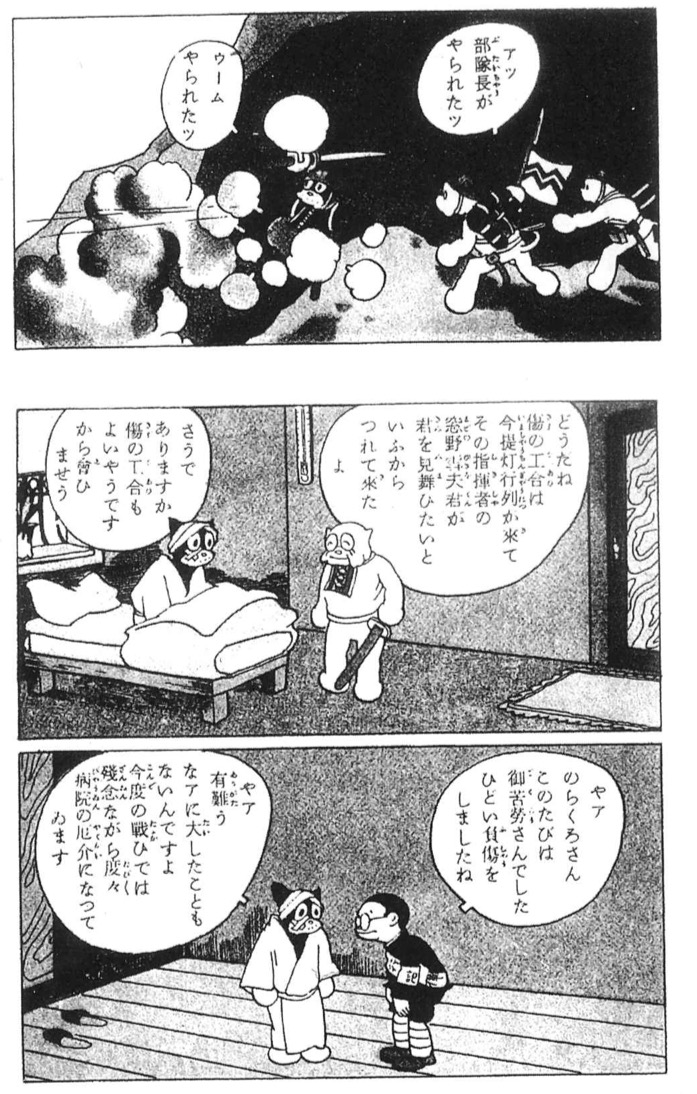
For example, Tagawa Suihō, whom I brought up earlier, had a manga entitled Tales of Norakuro the Valiant (Norakuro buyūdan), which was published in 1938 [the same year as the promulgation of the government’s publisher directives]. Tagawa makes his protagonist Norakuro suffer a terrible but glorious wound. He presents him dressed in a totally bandaged form to show him in such a pitiful state (Figure 4). Again, in another Tagawa manga, Norakuro Attacks on All Fronts (Norakuro sōkōgeki, 1937), we see the war situation on a map that immediately makes one think we are looking at China; Tagawa depicts his fictional Norakuro world in the actual reality of the Sino-Japanese conflict. He introduces, in a way, an objective sense of this “scientific” worldview into his manga’s war, and he deals out harsh wounds to the hero of a manga meant for children, who once expected that no one really dies in comics. This is where we begin to see a radical change take place in the images of the body in manga.12 We can say that this change takes place both because of the aspect of the regulation of artistic expression, and as a strong sign of the new scientific and progressive kind of thinking that was popular in Japan at this time.
As the war intensifies, except for war-propaganda manga (such as Kondō Hidezō’s Manga magazine and other leaflets dropped over the enemy) and animated films made to excite people for war, because there was a shortage on paper and materials, the manga market shrinks, and even Norakuro’s serialization comes to an end. Of course, it is not that children’s manga disappeared entirely, but there definitely was a condensation of the market. Immediately after Japan’s defeat and the end of the Pacific War in 1945, manga suddenly revives, and it explodes, and keeps on growing together with Japan’s postwar revival. Although there were some elements of prewar and interwar manga, the real development in manga is the acquisition of new postwar-era themes, and they grew together with the children who were born after World War II. This huge new population of postwar baby boomers—also commonly known as the mass generation (dankai no sedai)—will force open the manga market as they grow older. Manga publishers understood that this postwar generation was their new market, and will grow the industry in lockstep with the revival in the postwar economy and the later phase of Japan’s growth as a high-consumer society.
From 1945 to 1952, the defeated nation of Japan was administered by the U.S. Army. The General Headquarters of the Supreme Commander for the Allied Powers (GHQ) carried out its own form of media regulation and censorship that was, in a sense, a bit different from that carried out by Japan’s military during the war. Any kind of criticism of the Occupation or expressions that the GHQ thought were connected to militarism were strictly controlled; of course, Norakuro, that solider figure, now vanished. Any trace of jidaimono samurai-play disappeared; martial valor stories disappeared; in other words, gone were the worlds of boys’ stories that one saw before the war. Instead, the big hits now were Hasegawa Machiko’s Sazae-san (1946-1974) and other manga stories of domestic bliss; Fukui Kentarō’s and Ogawa Tetsurō’s Puccha in Wonderland (Fushigi no kuni no Pucchaa, 1946-1949) and other science-fiction futuristic stories; and Inoue Kazuo’s Batto-kun (Bat Kid, 1948-1949) and other cheerful baseball manga titles. The GHQ in the beginning was keenly sensitive about any expressions that had feudalistic elements like bushido, as they considered these associated with militarism. So kabuki plays of loyalty and valor or revenge pieces were outlawed; and even if they were not actually outlawed, chanbara swordplay stories, heroic war tales, etc., all were suppressed in the environment of the early days of the Occupation. Yet, eventually in the areas of movies and children’s manga, you began to see a revival of period pieces.13 This is the point in time when Tezuka Osamu suddenly appeared on the postwar manga scene, making his debut at age 17. Tezuka first becomes active in domestic-bliss manga and sci-fi stories [i.e., non-period or feudal stories], all the while in the background the GHQ Occupation is regulating the media.
What is interesting is that there are signs that the scientific-enlightenment ideology and depictions of everyday life, which were encouraged under Japan’s military government during the war, remained and even developed after the war. So, it might be possible to say that those domestic and SF manga defined the images of bodies in manga in the immediate postwar period. However, there was also a different aspect to those images. Take the baseball we see in Batto-kun. Of course, baseball is an American sport, but it was something that really captivated Japanese boys after the war. This manga perfectly symbolized the cheerfulness so characteristic of boys at that time; with the sense of democratic and collective progressivism it has, it is very easy to say that Batto-kun expressed themes and motifs common to postwar manga. In this way, baseball manga would increasingly become an important place for postwar manga for boys. The image we see of the sports-body proliferate in comics after the war comes from this lineage.
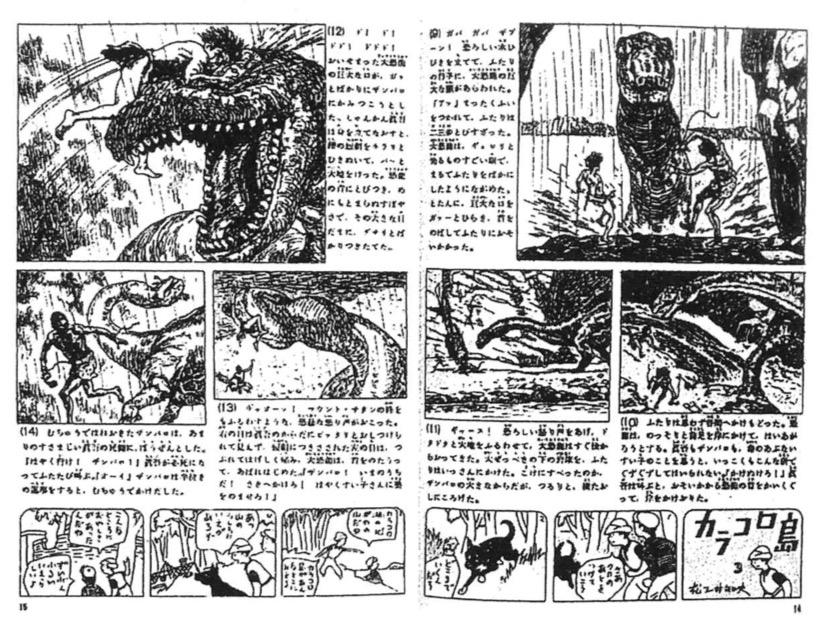
One more thing that quickly grows is a genre called the postwar “illustrated storybooks” (e-monogatari),14 which is a successor to the illustrations of stories (sashi-e) often seen in both boys’ and girls’ magazines, as well as the image of real bodies in adventure stories and super-detailed pictures in war tales for those works aimed at boys. Big works that endured as huge hits were Boy King (Shōnen ōja, Figure 5) a work by Yamakawa Sōji, who drew both sashi-e for magazines as well as kamishibai paper-picture theaters; Nagamatsu Takeo’s Golden Bat (Ōgon Batto), which had its start in kamishibai and was made into an “illustrated storybook” by 1947; and Komatsuzaki Shigeru’s and Fukushima Tetsuji’s Devil King of the Desert (Sabaku no maō). Devil King of the Desert and others had that feel of American comics, and the bodies drawn in them possessed a kind of reality unseen in the prewar children’s manga. Broadly speaking, I think e-monogatari is a development of the standard of “reality”, which had a hint of rationality, for prewar boys’ [non-manga] fiction. And, in the postwar period, these e-monogatari “illustrated stories” were established in the middle of: 1) manga that had image of the body and a worldview that can be represented by rubber men; and 2) prewar boy’s stories. The bodies drawn in these postwar illustrated books showed people with all their anatomical articulations. Even though the main character may be immortal in the plot, at least his body would look realistic. It was in this phase that postwar manga started to consistently show an impulse to depict things more realistically.15
Soon enough, though, from 1947, the GHQ began to relax its censorship efforts, and with that change came on a sudden revival of everything they had before suppressed. Returning to both fiction and manga were martial art pieces, historical pieces, and the lot.
Part 4: Manga-esque Bodies Doing Baseball and Martial Arts
I now would like to turn to an important topic concerning the kinds of bodies we see in Japanese comics. In Tezuka Osamu’s Until the Day of Our Victory (Shōri no hi made, 1947), which was a practice-work manga drawn in the final days of World War II, he packs in a lot of characters who are both Japanese and American; he also depicts the war and the bombings happening in Japan. It is a work that makes you think that, in and of itself, it was just a lighthearted bit of fun for the author, yet there is an exploding-bomb scene with a panel of a boy bending his body backward, face smeared with blood as he runs out of the way of machine gun strafing (Figure 6).

At the time, Tezuka lived in Osaka and he experienced the firebombing of the city. He has also written about what this was like in his own autobiography, revealing the trauma he suffered from it. This manga, I think, reflects how he himself experienced the war. In term of its body images, although it features people who have semiotic and rubbery human-like bodies, Tezuka was also drawing what it was like for real people to be wounded, to really die. This is around the same time that Tezuka drew another prototype work, Ghost Man (Yūrei-otoko, 1947), in which a robot is created by an evil scientist who works the robot to death. The robot calls out to [Tezuka regular character] Mustachio, begging him, “I want you to destroy all of us!” and there is even a “death” scene where the robot is melted down (Figure 7).
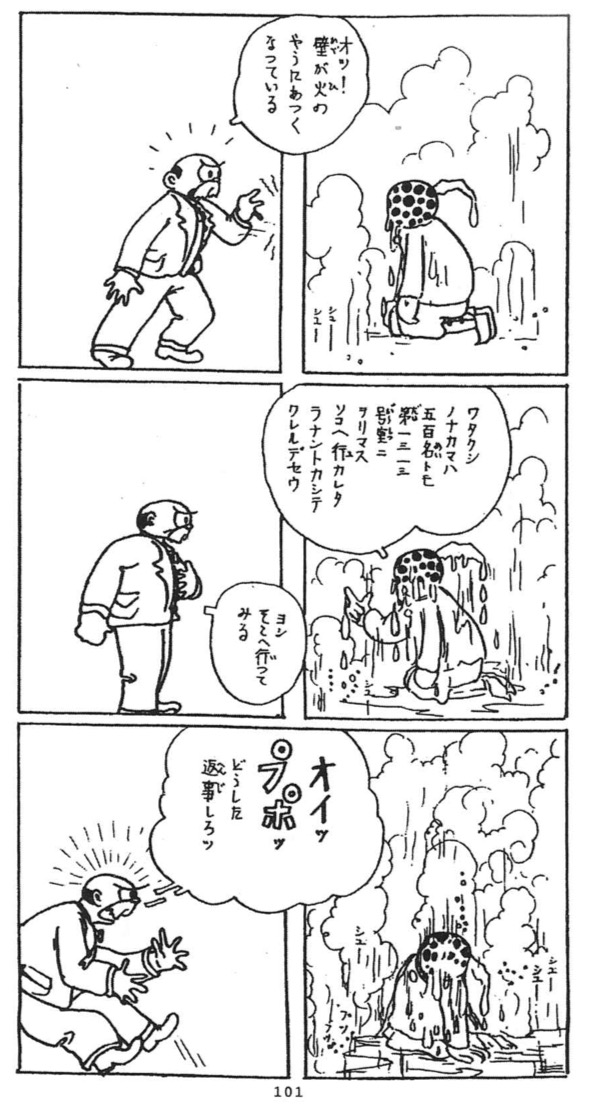
In this robot, which is anthropomorphized by Tezuka, we can see the another kind of image of a human-like body. That “bodies can really get hurt and die” is something that the war deeply ingrained in Tezuka and his manga - and, after the war, although he was drawing children’s manga, he would keep on drawing many tragic stories that included such “deaths” (shi). Although it looks like they are drawn in a cartoony and iconic style, he has images of people where it is possible to see them dying. It is possible to say that it was Tezuka Osamu who brought about a change in postwar manga with his stories, different from [earlier] manga that had those cartoony people with “bodies that never die” (zettai shinanai karada).
Ōtsuka Eiji writes that “Tezuka’s manga experienced a dramatic transformation from pre-war manga once Tezuka gave to his characters, which were illustrated in an unrealistic style like Norakuro or Mickey Mouse, bodies that would eventually die, that would become hurt and wounded in a real way.”16 Ōtsuka thus sees the beginning of postwar manga to be equal to Tezuka’s start. Furthermore, he sees that Tezuka was able to properly create characters that have “interiority” (naimen) with those bodies, which had obtained their own reality as a container of interiority. In other words, the theory Ōtsuka is advancing is that Tezuka made manga to have “bodies nearing death” (shini yuku karada), which appeared in Japanese fiction with the arrival of the modern Japanese novel [beginning in the 1880s]. Ōtsuka goes even further, and his is a quite interesting and dynamic discussion. He expands his focus to include the kind of semiotic expressions found in the bishōjo (beautiful girls) prevalent in Otaku (Geek) culture. I think the jury is still out on whether Ōtsuka was right or not to do that, and we certainly still need a number of studies to look at this point more. But, at the very least, when it comes to the image of body and this form of expression we call manga, his viewpoint has opened up lines of inquiry into important problems in our discourse of postwar manga.
Tezuka started drawing storytelling manga that feature multiple protagonists coming of age; this aspect exerted quite a heavy influence on those postwar manga artists, and in no time they all would completely drive out e-monogatari illustrated stories. More importantly, these artists went on to also change manga bodies. Of course, there is still some continuity with the rough and wild body images from before the war. For example, Sugiura Shigeru will make his manga bodies seem surrealistic (Figure 8).

And yet, on the other hand, when we get to Fukui Ei’ichi’s Igaguri-kun (Young Igaguri), which became a huge hit after the prohibitions on martial-arts stories ended, the artist draws judo scenes far more correct than anything like it in Tezuka’s manga. (For example, note the correctness of Fukui drawing a leg sweep or a shoulder throw.) Fukui also had practice scenes (Figure 9) where the depictions of body movement were actually quite precise and made sense. Of course, the protagonist himself never dies, never ages, but he does have a body that can get hurt (Figure 10). The bodies in children’s manga gradually begin to take on the qualities of natural bodies.
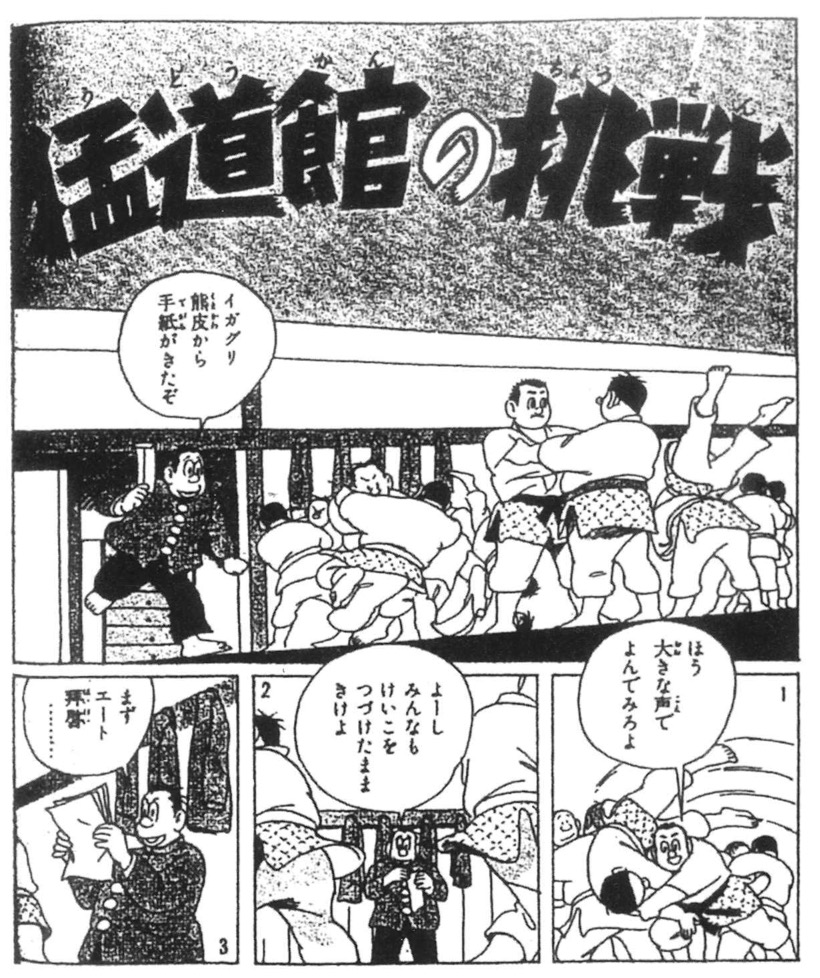
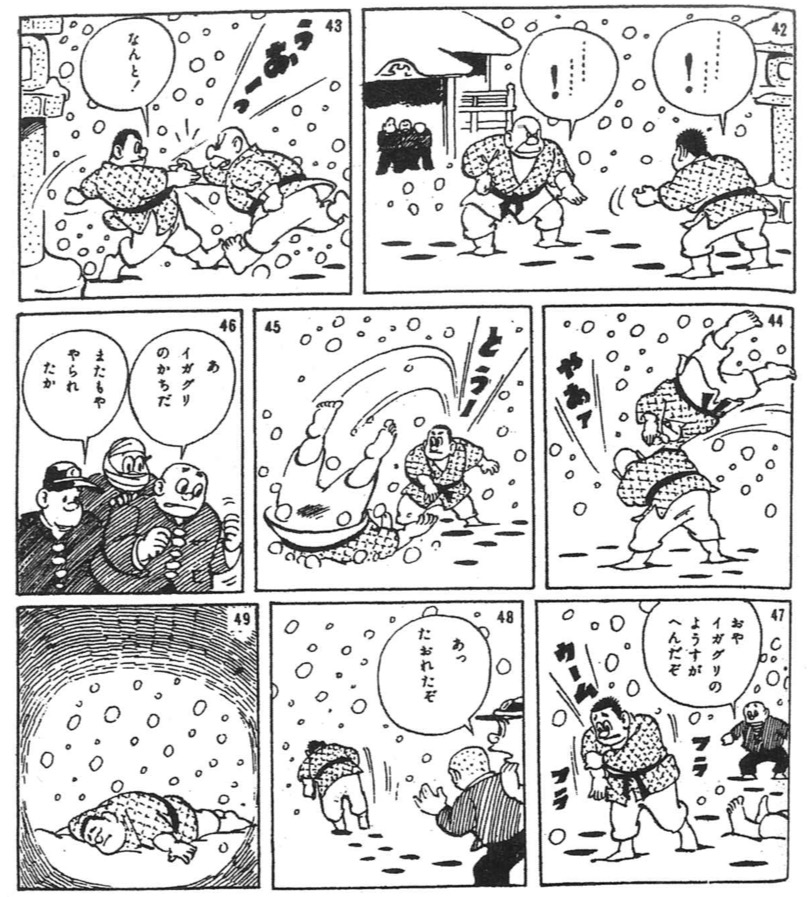
Then there is the samurai tale Akadō Suzunosuke (Suzunosuke, with the Red Breastplate), which began with Fukui, but because Fukui suddenly passed away, its serialization was carried out by Takeuchi Tsunayoshi, and it also became a huge hit. In the following example, the protagonist Suzunosuke, who is pursuing the way of sword, has been suspended in his training by his teacher, Chiba Shūsaku (who was a real late-Edo period master of a dōjō [a martial-arts academy]); Suzunosuke reads a book entitled “Heart and Sword”, which was recommended to him by his mother; it is then that he becomes awakened to his spiritual capacity (Figures 11a and 11b). This is probably a characteristic of Fukui's manga which inherited that sense of virtue from prewar boys’ stories.

In the same manga, there is a scene of Suzunosuke undergoing training and hearing a tedious explanation of the “slice-thru-vacuum” (shinkū-giri) special move (hissatsu-waza) (Figures 12a and 12b). The breakdown here is so talky and dense, nothing like it had ever previously been seen in prewar children’s manga. It makes us feel how there is a process that will link the training and the body, that also has a persuasiveness to it with a determined, clear logicality. Breaking down the meteorological phenomenon of the vacuum, called in Japanese “kama-itachi” (weather weasel), the master teaches the hero the technique of raising a whirlwind which produces the vacuum phenomenon. Even though the training scene is just one page long, we know that actually it has taken the hero two years to learn it all. What is informing scenes like this one is probably the faith in science and progress so common during the war. Once the trends of prewar shōnen novels get revived as martial-arts manga, we can see the transformation of the view of the body represented by the in-training body having a kind of reality to it.
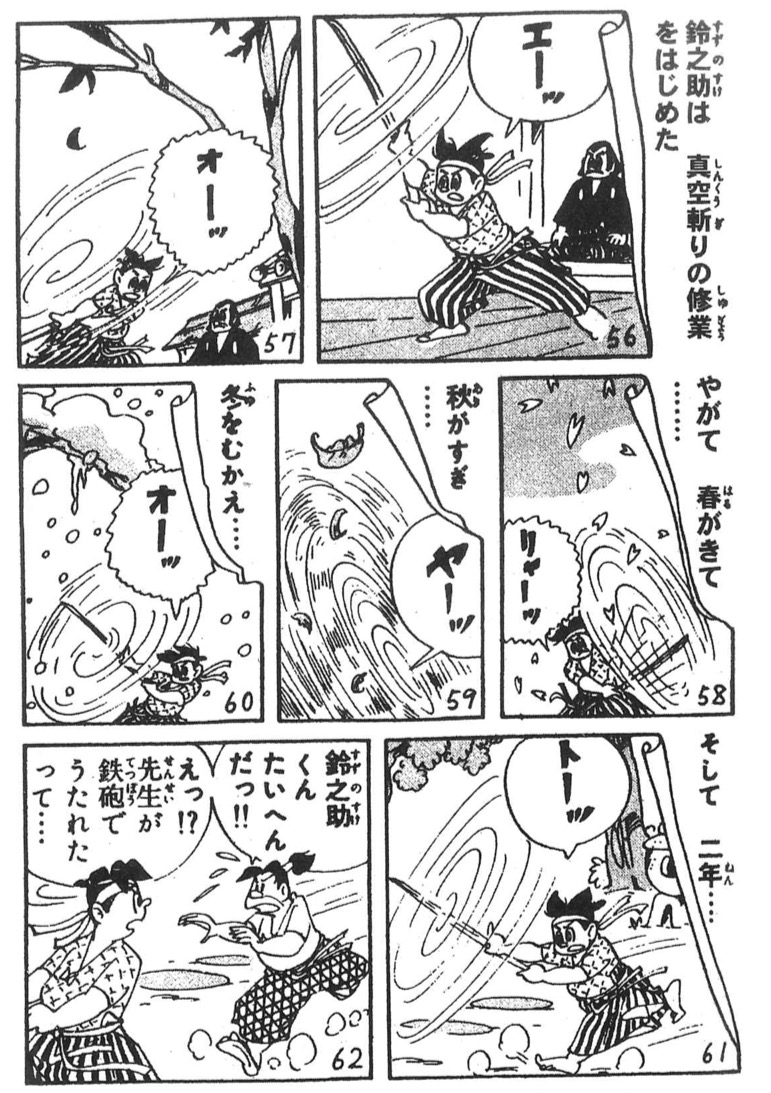
Next, we start to see a really interesting phenomenon. In the world of children’s manga, the sports body and the martial-arts body begin to merge. Kaizuka Hiroshi’s Bright-eyed Pitcher (Kurikuri tōshu, 1957-?) is a baseball manga that might be the granddaddy of all super-baseball stories. Its protagonist has an arm that can throw a hell of a pitch, called the “dorokkābu.” There is no logical explanation for this magic-ball pitch of his, but it is a move that, when combined the “drop ball” (doroppu) and the “curveball” (kābu), so they say, because the batter cannot tell which one is coming first there is no way anyone can hit it. What’s interesting here is when the protagonist's rivals appear on the scene. We meet Miyamoto Musashi and see his tama-tama ball, which flies as if flung from rough ocean waves when he pitches, seeming even to split into two. There is One-Armed Boy; Tange Uzen and his iai [a term used for a quick draw of a sword] throw; Sasaki Shōjirō at Ganryū Middle School, with his sparrow-hitting method; and so on. All these techniques and players in the manga are clearly modeled on famous martial artists from the time before the war (Figure 13).
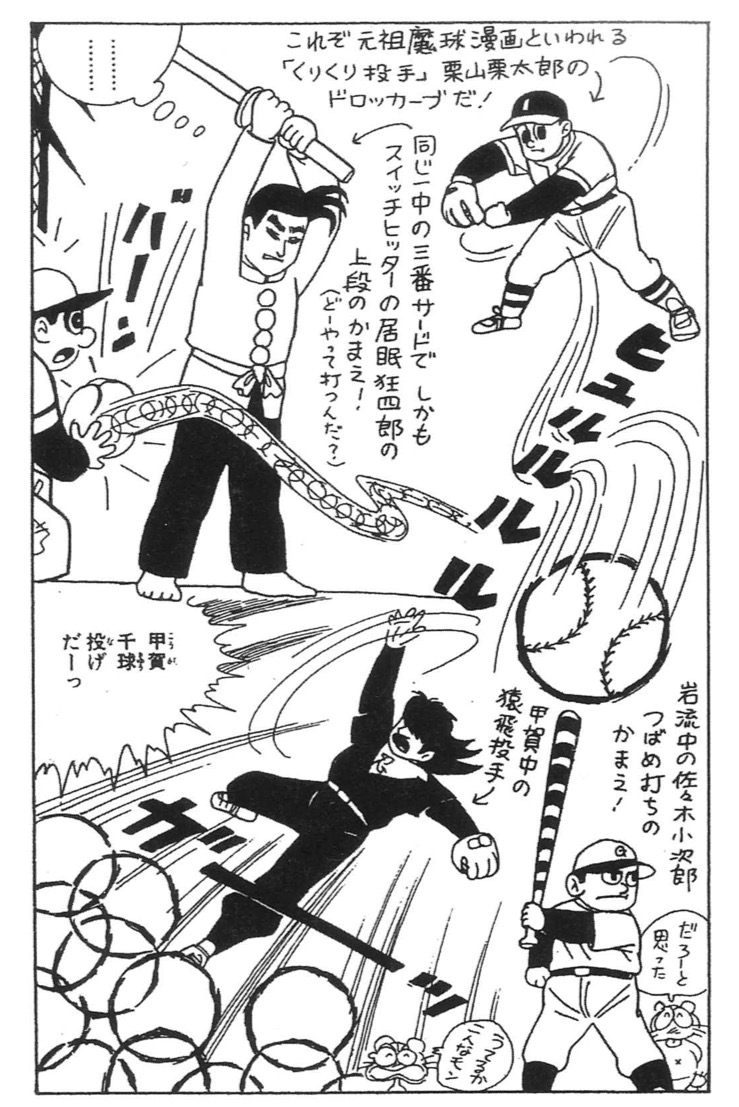
According to [the manga genre historian] Yonezawa Yoshihiro, “If I were to sum it up, once the [subgenre of] magic-ball manga was born, baseball [manga] acquired the structures of martial-arts techniques.”17 In other words, Yonezawa is saying that we see ninja, warrior, and baseball stories all come together. This kind of plot gets taken up by the shōnen magazine manga as the magazines transition from the monthly to weekly format; when we get to Fukumoto Kazuya’s and Chiba Tetsuya’s The Magic Ball of Promise (Chikai no makyū, 1961-62), the hero develops a pitch that is visible only in separate [frames], much like a ninja’s “incarnation trick”, and he learns from a mountain hermit the trick of “the disappearing magic ball” (kieru makyū). In Weekly Shōnen Magazine (Shūkan shōnen magajin), it is Fukumoto Kazuya again, but this time with Kazumine Daiji, and together they create a ninja story, entitled A Soldier’s Weapons with Dark Secrets (Kuroi himmitsu heiki, 1963-1965). Its protagonist is a ninja At one point, people in the world of baseball question, “should a ninja like that be allowed to play baseball?” Once they eventually learn that he takes up the required course of intense training, they allow him to play. But what we see is a kind of [process of] ninja methods, where the technique only comes through the daily training of one’s body that was mutated from the image of “ninjutsu” arts - the art that, before, would let you magically vanish in a poof just because you had a single scroll.
This legacy of this pattern continues on in the sports-guts (supokon) manga, and it reaches a point where it fully constructs the genres of sports manga we have today. There was thus a process that took place, stretching from a period of time from the 1950s through the 1960s, where these manga consolidated together baseball, which has postwar Japanese motifs that symbolized American influence, and martial-arts stories (along with their spiritualism), which resuscitated and preserved elements of prewar Japan. It is an extremely fascinating thing, which exemplifies both the historical continuity and discontinuity between prewar and postwar manga. Particularly, it is the training part of this process that might best show the preservation of elements of prewar Japanese spiritualism.
Part 5: The Socialized Body and Ninja Training
It is often thought that Tezuka innovated “bodies that will die” in postwar manga, while he was also innovating things with his layers of stories played by multiple protagonists who have their own lives. However, these elements did not actually have all that immediate an impact on other manga artists, and thus they were not carried on by them. Tezuka himself became a star author in the monthly manga magazines aimed at children after his period drawing those books called “akahon” (red-cover books), which lacked a solid central distribution network.18 Thus, it is not that he was able to consistently put out the same level and same quality of works one after another. It is during this period that the first manga artist who carried on the Tezuka-like tradition of multi-layered plot construction appears: that person is Shirato Sanpei, author of works like Scroll of Ninja Martial Arts (Ninja bugei chō, 1959-1962), who was working in the rental manga industry.19 Shirato drew from the well of kamishibai and illustrated tales that were popular during this time, but his ninja and other characters had bodies that were quite more realistic than those of the previous era; they also freely used martial arts techniques and ninjutsu arts that they learned through intense tests and physical training. Shirato added explanations about these feats that were really quite convincing and plausible at the time. So, when he presents a scene of a total massacre and tons of human heads go flying and blood is splattered everywhere, his “bodies that are near to death” enthusiastically go on gaining a very physical and freshly real kind of corporeality.
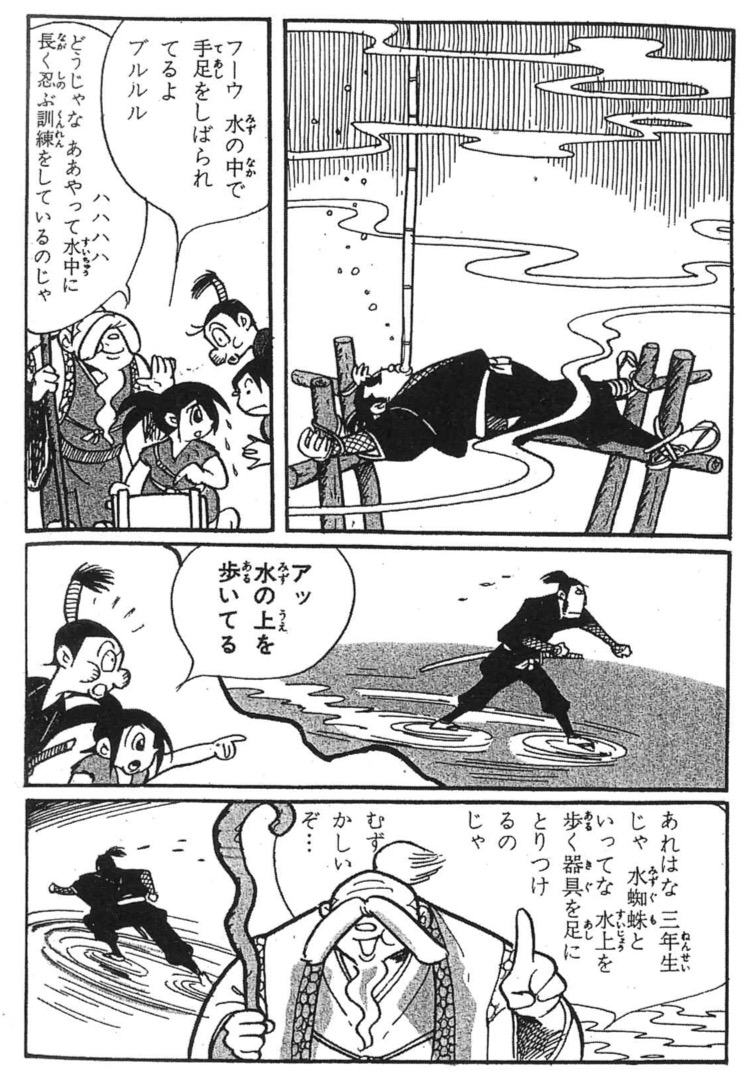
To talk about his kind of ninja training, Shirato emphasized from the start of his career the importance of scenes where the ninja gets trained through physical ordeals (Figure 14). The previously seen “ninjutsu”, where as long as you get the magic scroll you could suddenly disappear like it was some magic power, was replaced by Shirato. Now, one could only acquire such skills through painfully cruel tests of the body. “Ninjutsu” as a product of physical tests became the vogue as a part of a larger postwar boom in ninja fiction, but Shirato was drawing the same kinds of things and using those motifs in his manga around the same time. It is from about 1955, after the prohibition on jidaigeki (period) stories ends and we see the boom in historical fiction on the verge of taking off, that one then starts to see the common use of words like “ninja” and “ninja techniques” (ninpō).
Early Shirato works where he draws ninja, such as The Ninja Called Storm (Arashi no ninja) and Scroll of the Kōga Ninja Arts (Kōga ninpō chō), date from 1957 and 1958, but the [wider] ninja boom spans a similar time. For example, there are works like: Yamada Fūtarō’s serialized Scroll of the Kōga Ninja Arts (Kōga ninpō chō) in 1958 (which might be the start of the whole ninja tournament system of battle); Shiba Ryōtarō’s Owl’s Castle (Fukurō no shiro) in 1959; Murayama Tomoyoshi’s Ninja Part One (Shinobi no mono) in 1960 through its Akahata serialization in 1962; the 1962 film version of Murayama’s Ninja; and including, of course, Shirato’s own Scroll of Ninja Martial Arts. This is also around the same time where, in film, you see Kurosawa Akira make his films The Seven Samurai (Shichinin no samurai, 1954) and Yojimbo (Yōjinbō, 1961), which were divorced from the swordplay action movies up until that point and which also showed a new kind of body with their depictions of corporeality. In Shiba’s Owl’s Castle and Murayama’s Ninja, one also sees left wing ideology, such as postwar nihilism (Owl’s) or class conflict and revolution (Ninja), so we therefore see criticism of the contradictions of previous feudalistic eras more and more in these “real” works of historical fiction or in those films. Although this boom might seem to manifest a return to the kind of values belonging to prewar Japan, it really tells the story of a truly postwar phenomenon.

Shirato’s ninja tales are also rooted in the popular sentiment of anti-feudalism and anti-authoritarianism, as without a doubt this also comes back to the changes in society in the 1950s leading up to the 1960 Anpo movement.20 His Scroll of Ninja Martial Arts too reflected his view of class history; he often depicted scenes of the bodies of the masses and their group conflicts as symbolic of class conflict (Figure 15). He asserted much influence over even the young people making up the intellectual class, who were mainly university students. To have people drawn as “the masses” is something one sees in manga even from the prewar period. However, when the masses are drawn so their groups appear as social classes, it means that the image of the body-as-social-ideology could be captured in manga with its dynamic form of historical storytelling. And we can say that this depiction of bodies expanded the possibilities of postwar manga narratives. But it is also true that Shirato broke away from the herd at this time with his ability to convey explanations of martial arts that were greatly elaborate - so, for example, he could logically explain the “gale-wind sword” (shippū-ken), which appears in one of his works, as “a combination of pushing back the opponent’s sword and slicing their throat or right between his eyebrows […] so it is a movement of both strike [uchi] and defense [uke]”21 (which, I think, was an actual technique). Scroll of Ninja Martial Arts also features criticism of the feudalistic system and the [ruling] samurai class. During his training, a monk-like character who can use ninja arts at one point faces a samurai and [rhetorically] asks, “I guess it was not wrong for me to always think that swordsmanship was just another way to slaughter people?”22 an utter rejection of the kind of spiritualism seen in prewar works of shōnen fiction, which would have had a theme like “don’t cut with your sword, cut with your heart.” Actually, this is just another element that Shirato's manga had in common with other forms of “real” period-piece movies and fiction at the time.
Let me also go ahead and touch on one more thing, which is a new body image type with two possible differences. The first is the fully articulated, “real” body of male youth ninjas who undergo [intense] training; the second is the more cartoony [symbolic] and roundish kids that you see in the same manga. The former have a sense of reality to them that seem to come from the “illustrated stories” period, but the latter seem to derive from the bodies of children’s manga from before the war. What we thus see in Shirato’s manga is a confluence of visual depictions that are both very real and very free and loose because this perfectly overlaps with the period where we see a switch of postwar manga from something read by children to something young adults would also read. If we read a bit more deeply into this, the cartoonish conventions of manga are best symbolized in those innocent, pre-training bodies, while those seinen (young male), realistic bodies must indicate a kind of socialization acquired through the training process. Humans in a Shirato manga are basically absorbed into Nature’s ecological system - but, because they have been socialized, they will be depicted as people who can only exist bearing the contradictions [of human society]. You will find the same kind of construction in Marxism, but what is new here is the contradiction between the innocence that children’s manga had and the young adult-like reality that ends up all reflected in the kinds of bodies you see in a Shirato manga. In other words, the shift to reality in the training bodies might be best understood as a kind of metaphor for how people become adults (i.e., how they become socialized). Shirato’s mixture of free and loose depictions and realistic expressions guarantees the entertainment qualities of “art of ninja” (ninpō) itself, but it also, perhaps, best shows the contrast of the combined sensibility of the yearnings of the postwar masses with a sense of social reality.
Part 6: The Opposition between Society and the Individual
Just as the reproduction of the three-point perspective space is an illusion to show three-dimensional forms on a flat page, the body too, when it is reproduced with pictures—no matter how realistically it is depicted—is also nothing more than a fake body. After the 1960s, we have the so-called “gekiga” movement and its boom.23 As manga underwent a process of maturation [i.e., becoming geared towards young adult males, seinen-ka], it is said that manga became more “real”, but even so, no matter how “realistically” those pictures were drawn, the bodies therein were mere semblances. Both semiotic and realistic qualities of pictures are defined by something from a different level - namely, a standard set by the story. The image of the body too follows the same rules. As long as the [manga] story is supported and enjoyed by a large mass of people, I think we can safely agree that there is a duality of the different desires of this mass audience and the shared social sense of reality.
For example, in Star of the Giants (Kyojin no hoshi, 1966-1971), which was created by Kajiwara Ikki & Kawasaki Noboru, and which dominated the world of manga, we see a body put under great physical pressure and burdened with extremely heavy loads. For example, in the manga there is the famous scene involving “Major League Baseball Development Gips [i.e., an orthopedic cast]” (Figure 16), which, if you really did that kind of thing to a child during their development, surely it would harm their growth. There might be no meaning behind this fact, but I think it really had a strong impact on its very young readers for being realistic. Through the intense pressures put on the protagonist during his training, the spiritual aspect of training becomes all the more emphasized. We can say that this scene makes visible the power of his passion, which is normally something invisible. Star of the Giants was a manga that appeared during a period of excess, where the manga medium itself is getting more mature. Depictions like putting stress on the body might have been accepted as a kind of common thought, like some rite of passage to adulthood.
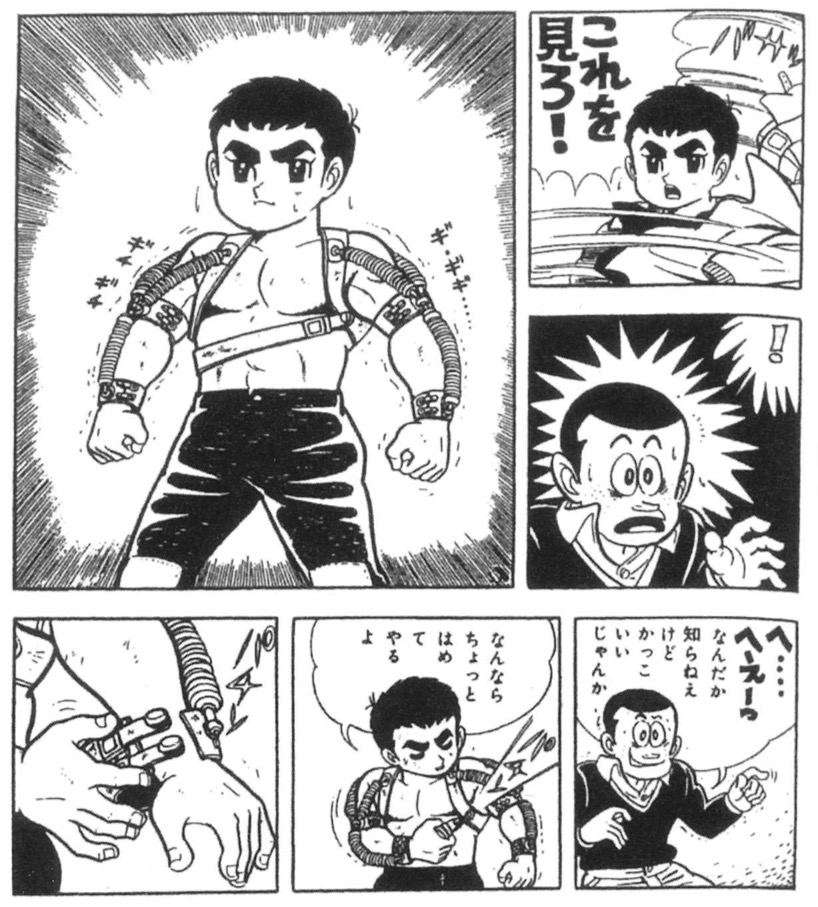
The same author, Kajiwara Ikki, would team up with Chiba Tetsuya for Tomorrow’s Joe (Ashita no Jō, 1968-1973), and together they would deliver an even further “matured” body; a hero with a “delinquent youth” body who could not be tamed by society; a body with the explosive power that comes from adolescent excess - and this body could express the battling techniques of boxing. I suppose we can say that these two images of the body symbolized the increasing seinen qualities of manga; far more than other manga, they applied a focus on the excessive contradictions that any socialized human being had. There is a scene where the Tomorrow’s Joe protagonist first learns boxing, where we see replays of the ways he does jabs and straight punches (Figure 17). This scene greatly advanced the reality of the training process.
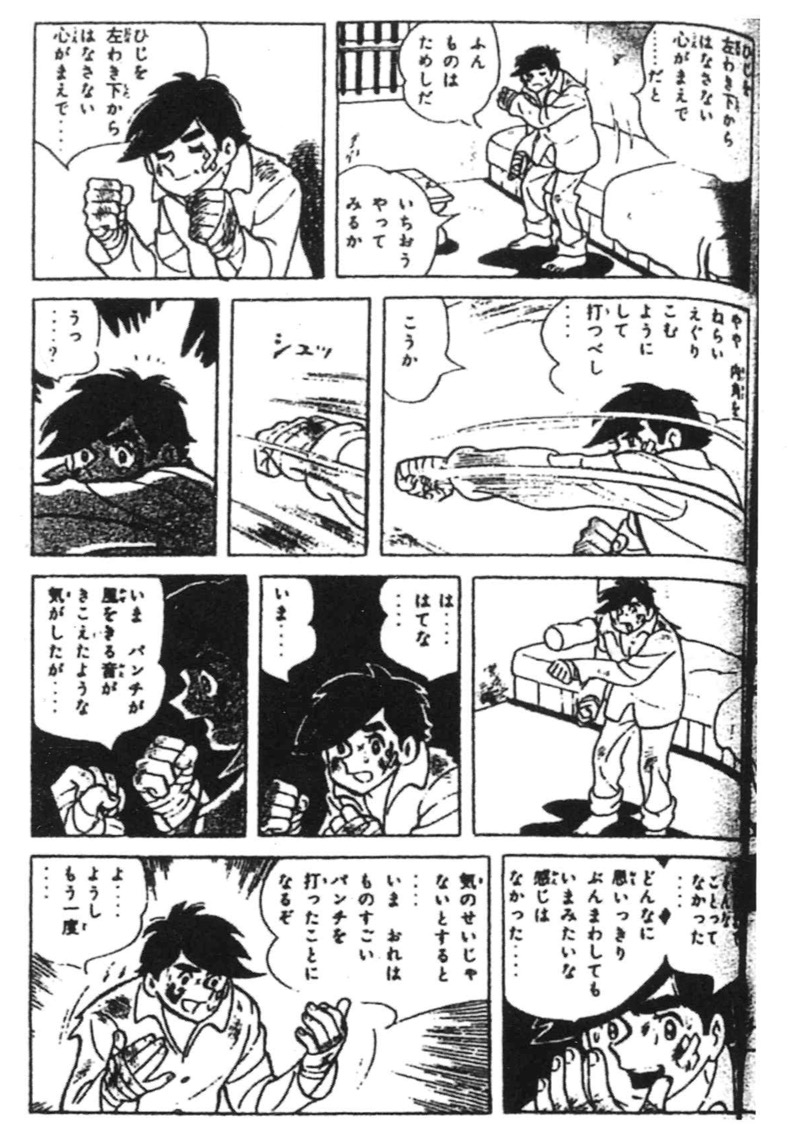
Takamori Asao), Chiba Tetsuya, Tomorrow’s Joe (Ashita no Jō), serialized in Weekly Shōnen Magazine (Shūkan shōnen magajin) from 1968 to 1973. Kōdansha Manga Bunko, Vol. 1, 2000 (reprint), pg. 173.
However, these two protagonists, who are truly representative of 1960s manga, will both go on to be utterly destroyed by the end of their stories. Put another way, their bodies, which have been socialized by such excessive training, become utterly frustrated because they refuse to compromise with that thing called society. That is why these two stories ultimately end in tragedy. Manga became a main part of 1960s youth culture, and also became a part of the counterculture. These two manga are deeply ingrained with the anti-social aspect of manga as a part of that counterculture. Such super-powers, which these young men gained through training, not only convey the exhilarating feeling that comes from manga as works of pure entertainment, but also gave birth to their bodies of tragic fate. When the meaning of training came to bear the possibility of becoming the tragedy of one's fate, we see the development of an aestheticism in the individual choosing to live as an individual, a dandyism of one sacrificing himself for some personal cause. I suppose that too reflects the view of the morality that young men (seinen) had. A Karate Idiot (Karate baka ichidai, 1971-1977) was also written by Kajiwara Ikki. While it might have a familiar truth-seeking training, A Karate Idiot greatly differs from the kind of “making-a-place-for-yourself-in-the-world” mentality (risshin-shusse-shugi) so common in prewar boys’ fiction, because A Karate Idiot pivots on the idea that the body must always be sacrificed for the sake of one’s personal sense of the beautiful.

Manga in this mold of youth culture/counterculture produces a new field, where we eventually see a new kind of manga, which is seinen manga, emerging from shōnen (boy’s) and shōjo (girl’s) manga. These works produce a new theme, which is perhaps best called “the restoration of bodies” (nikutai no fukken): popular ideas of the 1960s and 1970s influence them; there is born in them a general distrust of intellect, of logic, of words; there is a loss of faith in humans themselves, which is a global trend. Human Bullet Age (Nikudan jidai) was created by Miyaya Kazuhiko, who had a powerful influence as a kind of flag-bearer bringing seinen manga out of the 1960s. In it, Miyaya depicts the main character as a person completely absorbed in the grueling physical training of a boxer to fight off his existential crisis, but he ends up utterly destroying his body (Figure 18). The way that this boxer does this destructive fighting comes from a training style so harsh that it seems like he is bullying himself. At one point, he becomes terrified that his well-trained body will destroy his bones and kill him. Looking after him is an author (who seems a lot like Mishima Yukio), who discovers an aestheticism in this fear. In the manga, Miyaya expresses the need for the body to never stop fighting, even though the body is aware of its limitations and frustrations. In it, we sense Miyaya’s idea that to sacrifice one’s very own body could allow one to symbolically show one’s passion and sensibility while also rejecting modern-day rationality. I suppose we can read the work and see how the student movement of the times developed into a kind of belief only in physicality. Here, we sense that the mood of its time, which equated one’s sensibility to the revelation of bodies, had an influence on the images of bodies in manga.
Part 7: Systemized Bodies
Truth be told, I very much would also like to touch on bodies in shōjo manga as a separate topic (particularly those ballet manga, done by Yamagishi Ryōko and others), but since my space here is limited, I will move on to my conclusion. After 1970, in Japanese comic books, we see the development of seinen (young men’s) manga, and, until we reach the peak of that market in 1996, we truly see the opening up of the field with a rich diversity of artists and works, with those artists cracking open all-new kinds of subject material. Up until this point in my essay, I’ve been discussing the images of bodies and training bodies, so we have gone from truly semiotic “bodies that do not die” to realistic “bodies going to die”, and it might look at first glance like this is the history of [manga’s] development where stories were able to achieve dense and complex narratives. However, both elements currently still coexist in manga, as seen in the contrast of contemporary works like Yoshikawa Eiji’s & Inoue Takehiko’s Vagabond (Bagabondo, 1998-present), which has been a bestseller in recent years, to One Piece, which I touched on at the start of this essay. All kinds of levels of these types of [body] expressions continue to be drawn simultaneously, sometimes within the same work, across multiple works, or even across the trends in this area of manga publishing. The market has grown with multiple layers that follow the interests of multiple reader groups, meeting the tastes of all their readers, with their different social backgrounds, their genders, and their different age levels. And so, these stories have manga-ized the desires of various readers by taking forms that can accommodate their senses of reality and what they all variously yearn for. We can probably say that, from the 1970s through the 1980s, Japanese comics (those originally meant for children) were able to acquire a blueprint for expression that could guarantee such diversification thereafter, and that manga artists have chosen images of bodies depending on the demands of their stories.
But if you ask me if no significant transformation of the training-body image took place after the 1970s, I can tell you that is simply not true. First of all, the depictions of training, at least in the battle genre in the shōnen magazines, gradually became lighter in tone, and even parodied; we see a shift where the training body extends into metal mechanisms that become parts of the human body, as seen in giant mecha works. Then, there is a trend to have the image of the body go back to that fantasy of transcendence that had a religious or spiritual aspect. While purity, which has been a main theme of most shōnen stories, still survives, a new type of battle genre manga became popular This type of battle manga very much has the adolescent body as its main theme, where the more twists in his spirit a character has, the stronger he becomes. This transformation of body image, then, can be seen as a distillation of the zeitgeist from when people had a sense of being worn down as their reality was becoming a mere fabrication. Perhaps we can say that, in the larger picture, this cannot be unconnected to the shift in Japanese society around the 1970s, when Japan suddenly truly becomes a high-level consumer society as we go from “a period of ideals” into a “period of fabrication”.24
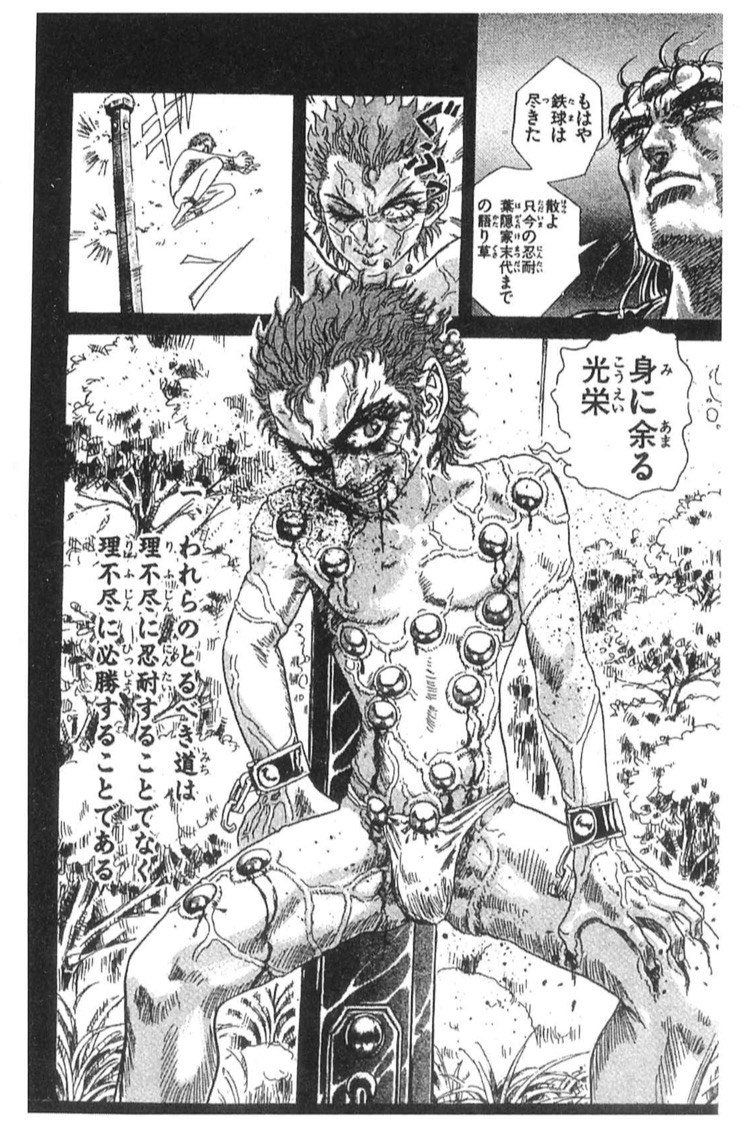
Finally, let me give you a good example. In his Apocalypse Zero (or: Encouragement of Resolve, [Kakugo no susume], 1994-1996), Yamaguchi Takayuki created a fairly unique kind of battle manga. The young male protagonist and his enemy older brother (who, for some reason, has a female body when he morphs), had numerous metal balls shot into their bodies by their father - and, because the metal balls were absorbed by their bodies, when it comes time to fight, the older brother can augment most of their body surface with metal shielding (Figure 19). These training scenes make us feel a sense of pain in the body and its aesthetic. This manga is a work that is totally imbued with freakish intention, a tendency for both cruelty and deformity, and for erotic expression. This is a combination of various elements from “Otaku Culture”, and it might even seem like a parody of shōnen manga in the battle subgenre, but it really reminds me of the “Body Aesthetics” (nikutai no bigaku) of authors like Kajiwara Ikki and Miyaya Kazuhiko. Considering that this manga has to it an aspect containing multiple elements of postwar manga in an Otaku-like fashion, those metal balls making the human bodies metallic really seem to me like a metaphor for the systems and mechanisms of giant robots that flow back into and eat away at the bodies of humans. This work also appears around the same time as Neon Genesis Evangelion (1995-1996), where we saw in anime those scenes of the young male protagonist having his body merged into the system of a giant robot body. I cannot help but think that these works reveal the image of bodies that we had [in the 1990s], when [Japanese] people were having a hard time determining what boundary separates them from their emptied-out, purely signified society - or, what separates them from truths that become regularly falsified.
If it is true that manga’s body-in-training images could reflect, in a somewhat backward manner, the zeitgeist of how people saw the body being socialized, now that we have reached this point [the 1990s], then manga, which once had an opposition between the individual and society, might simply produce structures in which our systems of society have directly replaced the forms of our human bodies.
* * *
- John E. Ingulsrud and Kate Allen, Reading Japan Cool: Patterns of Manga Literacy and Discourse (Lexington Books, 2009), 53.
- Ingulsrud and Allen, Reading Japan Cool, 53.
- Manga henshūjutsu (Byakuya Shobō, 1999), 29-30.
- In terms of the establishment of linear perspective and European realism, see Satō Tadayoshi, Nakamura Yūjirō, et al., The History of the Spirit of Perspective: How Has the Human Eye Understood Space? (Enganhō no seishin-shi: Ningen no me wa kūkan o dō toraete kita ka [Heibonsha, 1992]).
- For more about the modern systemization of comic panels, see Thierry Groensteen, The System of Comics (available in Japanese as Manga no shisutemu: Manga wa naze monogatari ni naru no ka [Seidosha, 2009]); see also Sasaki Minoru, “From Where Did Frame-Arrangement Comics Originate?: Modern European Cultural History and the Back Story with Hogarth, Töpffer” (“Komawari manga wa doko kara kita ka—Hogāsu, Tepufēru no shutsugen to, sono haikei to shite no kindai Yōroppa bunka shi,” [Narrative Media Kenkyūkai, No. 2 (2010)]).
- Please see Maki Yūsuke, Comparative Sociology of Time (Jikan no hikaku shakaigaku, [Iwanami Gendai Bunko, 2003]) for more about time and modernity.
- When it comes to the history of manga made from the end of the Bakumatsu Period [i.e., the end of the reign of the Tokugawa samurai order before the start of the Meiji Period in 1868] through Japan’s prewar period, see Shimizu Isao, The History of Manga (Manga no rekishi, [Iwanami Shoten, 1991]) and his Birth of Japan’s Modern Manga (Nihon kindai manga no tanjō, [Degawa Shuppansha, 2001]).
- [Translators’ Note] "Tengu" are half-bird, half-human creatures in the Japanese monster (yōkai) pantheon, often with powers of sorcery in addition to being able to fly. They also overlap with the real mountain mystics of the Japanese Shugendō religious tradition, which contains elements of Buddhism, Shintō, and Daoism.
- Tachikawa Library (Bunko) was a series of mass-entertainment stories marketed to younger audiences that were based on raconteur (kōdan) yarns; some became very famous, like Sanada Ten Warriors (Sanada Jū Yūshi), Sarutobi Sasuke, etc. These became quite widespread from the Meiji [1868-1912] through the Taishō period, and even after that time the company Kōdansha (known before WWII as Dai Nippon Yūbenkai Kōdansha [Great Japan Heroism Storytellers Company]) voluminously published a similar kind of popular reading material. The paper-show theatre presenters drew on the popular puppet plays from the Meiji period, and, from the early Shōwa Period [i.e, from 1926], became established by their intense activity working on street corners and in alleys selling candies with stories geared towards children. These paper artists often incorporated the techniques of movies of the time, and they were quite popular even up through the war and into the 1950s - including their centric popular pieces of katsugeki (action drama). For more, see the Asahi Graph Special Issue Interwar and Postwar Kamishibai Collection (Senchū sengo kamishibai shūsei, Asahi Shinbunsha, 1995) and Yamamoto Taketoshi, Kamishibai (Yoshikawa Kōbunkan, 2000).
- This training method works with the idea that hemp grows extremely fast, so even if in the beginning it is just a sprout, if you leap over it every day, soon you can attain flying/leaping power like a supernatural being. In Kida Gen’s commentary to Ninja: Part Four (Murayama Tomoyoshi’s Shinobi no mono: Yon, Iwanami Gendai Bunko, 2003), Professor Kida touches on the hemp-leaping training that one sees in the manga. It first appeared in Yoshikawa Eiji’s novel Tenpei Dōji (serialized from 1937 to 1940 in Shōnen Club). Professor Kida remembers that, as a boy, he tried to do these things himself.
- For more on this topic, please see Miyamoto Hirohito’s “Manga and Vehicles: New Treasure Island and Its Precursors” (“Manga to norimono: Shin Takarajima to sore izen”), in Shimotsuki Takanaka’s It’s Born! The Cultural Context that Shaped the “Tezuka Osamu,” Manga God (Tanjō! “Tezuka Osamu” no kamisama o sodateta bakkuguraundo (Asahi Sonorama, 1998).
- See Miyamoto Hirohito’s article “The Half-Life of a Certain Dog: Norakuro and ‘War’” (“Aru inu no hansei: Norakuro to 'sensō'”) in Manga Research (Manga kenkyū) No. 2 (Manga Kenkyū Gakkai, 2002).
- See Natsume Fusanosuke’s Manga and “War” (Manga to “Sensō”), Kōdansha Gendai Shinsho, 1997, 25.
- What were “illustrated books”, or e-monogatari, in the postwar period? Broadly speaking, at this time you had the humorous verbal-manga (manga manbun) style from Okamoto Ippei’s, Oda Shōsei’s and Kabashima Katsuichi’s cartoon, The Adventures of Masa-chan (Masa-chan no bōken, 1923-26), and so on. All of these examples are in a storytelling style that has words appear alongside pictures. In a narrower sense, it points to the genre that was popularized by Yamakawa Sōji and his colleagues after the war. Strictly speaking, there was no clear distinction between e-monogatari and manga, and the boundary separating them from things like illustrated (children’s) books was also vague. Here, I’m using this term in the latter (narrower) definition.
- [Editor's Note] For more on postwar e-monogatari, readers may avail themselves of Ryan Holmberg's 2011 essay Emonogatari in the Age of Comics, 1948-1957.
- Ōtsuka Eiji, The Astro Boy Proposition: The Themes of Tezuka Osamu and Postwar Manga (Atomu no meidai: Tezuka Osamu to sengo manga no shudai, [Tokuma Shoten, 2003]), 158.
- Yonezawa Yoshihiro, The History of Postwar Baseball Manga: A World without Tezuka Osamu (Sengo yakyū manga shi: Tezuka Osamu no inai fūkei [Heibonsha Shinsho, 2002]), 57-58.
- “Akahon” (red-cover books) had been a term used since the Edo Period [1600-1868], but in the modern period it came to be used differently from books published by publishers who had a centralized distribution powers. Akahon came to mean publications of manga and such that would be sold at the same time with sweets and candy at nighttime festival stalls and odds-and-ends shops. However, there are cases, such as Nakamura Shuppan publisher’s Manga Library (Manga Raiburarī) series, where you see akahon manga with impressively original quality and dense story content. Tezuka was influenced by such manga, and he himself would go on to publish his own akahon manga as his first works, possessing great qualities all the way up to the early years of the 1950s.
- Just as if they came in right at the last gasp of the akahon manga boom, the rental manga market has a peak period beginning in the late 1950s, where its short story manga and feature-length books were extremely popular. The distribution of rental store manga existed almost until the end of the 1960s. For more on this, see Rental Manga Returns (Kashihon manga RETURNS), edited by the Kashihon Manga Shi Kenkyukai (Popura Sha, 2006).
- [Translators’ Note] In 1960, Prime Minister Kishi Nobusuke sought to renew the U.S.-Japan Security Treaty from 1950, which would re-normalize relations with the United States in the fight against Communism and the Soviet Union, despite a broad lack of support across Japan. “Beginning in late 1959, street demonstrations against the security treaty grew larger and more intense,” write historians Mikiso Hane & Louis Perez, but “political agitators together with radical leaders of the National Student Federation organized mass demonstrations against Kishi. There was also widespread public support for the movement to ‘defend democracy.’” (Mikiso Hane and Louis G. Perez, Modern Japan, [Westview Press, 2013], 387). Although the treaty was renewed in June 1960, and the student “demonstrators may have failed to prevent the ratification of the mutual security treaty,[...] they did succeed in bringing about the downfall of Kishi... the last of the prewar and wartime political leaders to assume power in postwar Japan” (388). These “massive demonstrations,” writes Doryun Chong, thus opened the 1960s and inaugurated a large number of student uprisings and anti-Vietnam War rallies, “but the decade closed with government crackdowns precluding any possibility of protests on the scale of those in 1960” (Tokyo, 1955-1970: A New Avant-Garde [MoMA, 2012], 30). For more about the connection between the student movements that grew out of Ampo protests and manga, see John Treat’s chapter “Reading Comics/Writing Graffiti” in his The Rise and Fall of Modern Japanese Literature [Univ. of Chicago Press, 2018], 201-224).
- Scroll of Ninja Martial Arts (Ninja bugei chō, [Shōgakukan Creative Facsimile Edition, 2009]), Vol. 1, 140.
- Scroll of Ninja Martial Arts, 136.
- The term “gekiga” differs in terms of principles depending upon who uses it and it can easily cause some confusion. Historically, there was: 1) the early use of the term gekiga by artists such as Tatsumi Yoshihiro, who worked in the rental manga book industry; later, 2) it is a term used to describe artists who applied the similar visual expressions to the ones developed in the rental book market, which includes artists like Shirato Sanpei and Hirata Hiroshi, etc.; and then 3) the term gekiga was a designation employed in the seinen (young adult) manga magazines, and it becomes a kind of generally-used term. There are many changes in these three stages alone. It also refer to quite different things if people emphasize the manga’s form or the manga’s content, etc. There even was a tendency to use “gekiga” to refer to things like American comic books, French and European BD, and such.
- Ōsawa Masachi, in his book The Age of Impossibility (Fukanōsei no jidai [Iwanami Shinsho, 2008]), writes that Japan underwent a shift in the 1970s, where a central mode of disorder exists under the surface of an otherwise seemingly real sense of order; we go from the time of “ideals,” when Japan was regulated by the United States, into the age of the 1970s, an “age of falsehoods,” which, he says, “becomes characterized by an overall relativism towards even truth with numbers of false constructions, where the truth becomes seen as a kind of falsehood that has come to be framed through the systems of language and signs and structures” (68). Furthermore, Ōsawa greets the end of this “age of falsehoods,” emphasizing that we are now in the process of entering an “age of impossibilities,” where “reality” appears in different forms.



